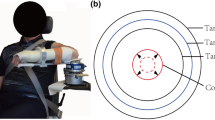Abstract
We examined the time-varying dynamics of the human triceps surae stretch reflex before, during, and after a large stretch was imposed upon the ankle joint, during a constant voluntary contraction of 15% of maximum voluntary contraction. Stretch reflex dynamics were estimated by superimposing a small stochastic displacement on many such stretches and using an “ensemble-based” time-varying identification procedure to compute impulse response functions relating the perturbation to the evoked electromyogram (EMG) at each point throughout the task. We found that stretch reflex magnitude (relating joint velocity to EMG) varied directly with baseline EMG activity during steady-state conditions before and after the large imposed stretch. Following the large stretch and the reflex activity it evoked, both background EMG and stretch reflex magnitude declined for up to 100 ms; changes in the stretch reflex were substantially greater in magnitude and followed a different time course from the corresponding changes in background EMG, however, indicating that stretch reflex properties were modulated independently of motoneuron pool activation level. Based on timing and the invariance of stretch reflex dynamics across time, it is argued that this behavior is largely mediated via peripheral neural mechanisms. This peripheral modulation of the stretch reflex presumably supplements various descending influences to adjust reflex properties.
Similar content being viewed by others
References
Allum JHJ, Mauritz K-H (1984) Compensation for intrinsic muscle stiffness by short-latency reflexes in human triceps surae muscles. J Neurophysiol 52:797–818
Baldissera F, Hultborn H, Illert M (1981) Integration in spinal neuronal systems. In: Brooks VB (ed) Motor control. (Hand-book of physiology, sect 1, The nervous system, vol II) American Physiological Society, Bethesda, Md., pp 509–595
Barnes CD, Pompeiano O (1970) Presynaptic and postsynaptic effects in the monosynaptic reflex pathway to extensor motoneurons following vibration of synergistic muscles. Arch Ital Biol 108:259–294
Berardelli A, Hallet M, Kaufman C, Fine E, Berenberg W, Simon SR (1982) Stretch reflexes of triceps surae in normal man. J Neurol Neurosurg Psychiatry 45:513–525
Bigland-Ritchie B, Woods JJ (1984) Changes in muscle contractile properties and neural control during human muscular fatigue. Muscle Nerve 7:691–699
Brown MC, Engberg I, Matthews PBC (1967) The relative sensitivity to vibration of muscle receptors of the cat. J Physiol (Lond) 192:773–800
Burke RE (1981) Motor units: anatomy, physiology, and functional organization. In: Brooks VB (ed) Motor Control. (Handbook of physiology, sect 1, The nervous system vol II) American Physiological Society, Bethesda, Md, pp 345–422
Capaday C, Stein RB (1986) Amplitude modulation of the soleus H-reflex in the human during walking and standing. J Neurosci 1308:131
Capaday C, Stein RB (1987) Difference in the amplitude of the human soleus H reflex during standing and walking. J Physiol (Lond) 392:513–522
Devanandan MS, Eccles RM, Yokota T (1965) Muscle stretch and the presynaptic inhibition of the group Ia pathway to motoneurons. J Physiol (Lond) 179:430–441
Dufresne JR, Soechting JF, Terzuelo CA (1980) Modulation of the myotatic reflex gain in man during intentional movements. Brain Res 193:67–84
Gottlieb GL, Agarwal GC (1979) Response to sudden torques about ankle in man: myotatic reflex. J Neurophysiol 42:91–106
Gottlieb GL, Agarwal GC (1980) Response to sudden torques about ankle in man. III. Suppression of stretch-evoked responses during phasic contraction. J Neurophysiol 44:233–246
Hoffer JA, Andreassen S (1981) Regulation of soleus muscle stiffness in premammillary cats: intrinsic and reflex components. J Neurophysiol 45:267–285
Kearney RE, Hunter IW (1983) System identification of human triceps surae stretch reflex dynamics. Exp Brain Res 51:117–127
Kirsch RF, Kearney RE (1992) Identification of time-varying dynamics of the human triceps surae stretch reflex. II. Rapid imposed movement. 14th Annual International Conference IEEE Engineering in Medicine and Biology Society, 14:1428–1429
Kirsch RF, Zarkadas PC, Kearney RE (1992) Modulation of stretch reflex gain during an imposed movement of the human ankle joint. Proceedings of the 18th Canadian Medical and Biological Engineering Conference, Canadian Medical & Biological Engineering Society (CMBES) Ottawa, 18:54–55
Kirsch RF, Kearney RE, MacNeil, JB (1993) Identification of timevarying dynamics of the human triceps surae stretch reflex. I. Rapid isometric contraction. Exp Brain Res 97:115–127
Lundberg A (1975) Control of spinal mechanisms from the brain. In: Tower DB (ed) The basic neurosciences. (The Nervous System, vol I) Raven, New York, pp 253–265
Lundberg A, Malmgren K, Schomburg ED (1975) Convergence from Ib, cutaneous, and joint afferents in reflex pathways to motoneurons. Brain Res 87:81–84
MacNeil JB, Kearney RE, Hunter IW (1992) Identification of timevarying biological systems from ensemble data. IEEE Trans Biomed Eng 39:1213–1225
Marsden CD, Merton PA, Morton HB (1976) Servo action in the human thumb. J Physiol (Lond) 257:1–44
Matthews PBC (1986) Observations on the automatic compensation of reflex gain on varying the pre-existing level of motor discharge in man. J Physiol (Lond) 374:73–90
Meunier S, Pierrot-Deseilligny E (1989) Gating of the afferent volley of the monosynaptic stretch reflex during movement in man. J Physiol (Lond) 419:753–763
Mortimer JA, Webster DG, Dukich TG (1981) Changes in short and long latency stretch responses during the transition from posture to movement. Brain Res 229:337–351
Nichols TR, Houk JC (1976) Improvement in linearity and regulation of stiffness that results from actions of stretch reflex. J Neurophysiol 29:119–142
Soechting JF, Dufresne JR, Lacquaniti F (1981) Time-varying properties of myotatic response in man during some simple motor tasks. J Neurophysiol 46:1226–1243
Toft E, Sinkjaer T, Andreassen S, Larsen K (1991) Mechanical and electromyographic responses to stretch of the human ankle extensors. J Neurophysiol 65:1402–1410
Weiss PL, Kearney RE, Hunter IW (1986) Position dependence of stretch reflex dynamics at the human ankle. Exp Brain Res 63:49–59
Yang JF, Stein RB, James KB (1991) Contribution of peripheral afferents to the activation of the soleus muscle during walking in humans. Exp Brain Res 87:679–687
Author information
Authors and Affiliations
Rights and permissions
About this article
Cite this article
Kirsch, R.F., Kearney, R.E. Identification of time-varying dynamics of the human triceps surae stretch reflex. Exp Brain Res 97, 128–138 (1993). https://doi.org/10.1007/BF00228823
Received:
Accepted:
Issue Date:
DOI: https://doi.org/10.1007/BF00228823




